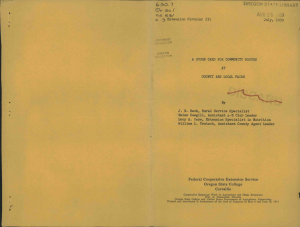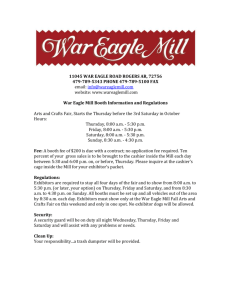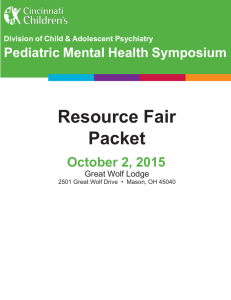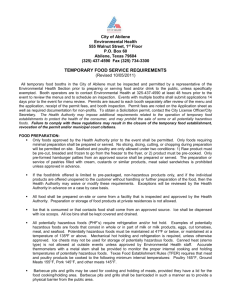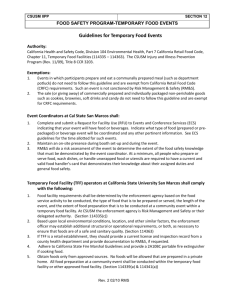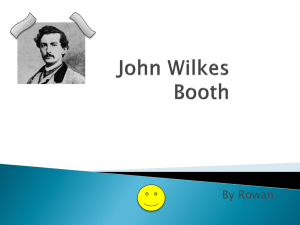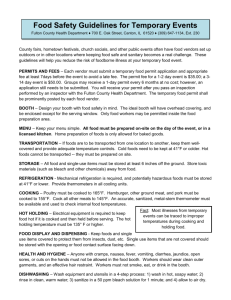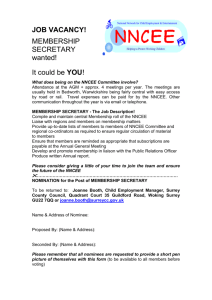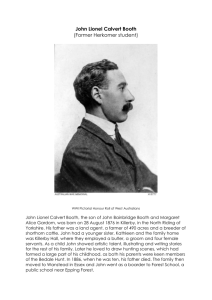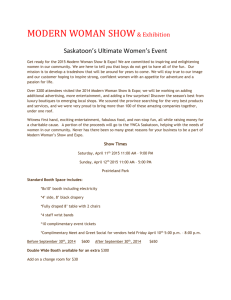TEMPORARY FOOD FACILITY - El Medio Fire Protection District
advertisement
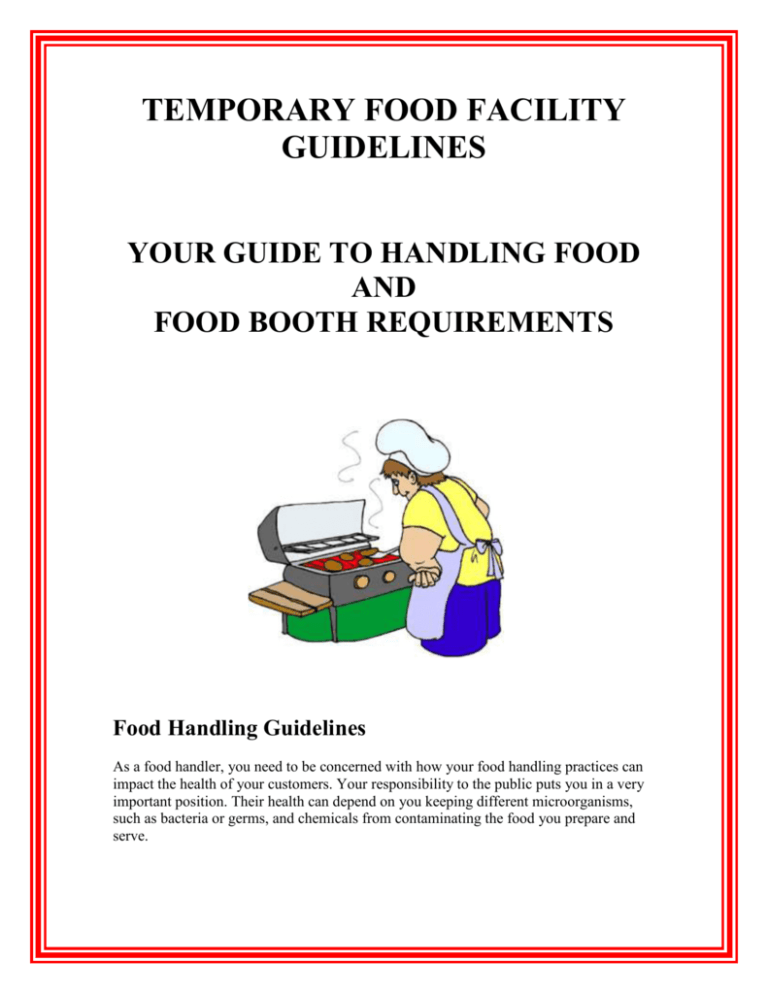
TEMPORARY FOOD FACILITY GUIDELINES YOUR GUIDE TO HANDLING FOOD AND FOOD BOOTH REQUIREMENTS Food Handling Guidelines As a food handler, you need to be concerned with how your food handling practices can impact the health of your customers. Your responsibility to the public puts you in a very important position. Their health can depend on you keeping different microorganisms, such as bacteria or germs, and chemicals from contaminating the food you prepare and serve. The following guidelines are to help you provide safe and healthful food to the public, and to show you how to prevent food-borne illness. By working together, we can protect the health and safety of the public, and keep your customers coming back for more! How can I protect food from contamination? When food is not handled properly, your customers run a high risk of getting a foodborne illness. Food-borne illness usually means flu-like symptoms (such as diarrhea, vomiting, fever, stomach cramps, and headaches), but can be more serious for some people. You can protect your customers from getting sick by following these three steps to keep food safe: Keep hot food HOT - 135°F or higher! Keep cold food COLD - 45°F or lower! Keep all food PROTECTED! Food can be exposed to chemical and bacterial contamination during production, packaging, transportation, preparation, storage or service. Chemical contamination can be caused by using utensils/equipment for cooking that are not meant for food preparation or by accidentally adding chemicals or insecticides to food. Even using too much of some food “spices” (such as monosodium glutamate or Accent) can cause severe headaches, vomiting or diarrhea. Bacterial contamination is caused by germs growing in foods. People also spread germs through their hands, hair, coughing, and sneezing. Bacteria need four things to grow and reproduce: moisture, warmth, time, and a source of food. The growth of bacteria can be controlled by cooking and reheating food quickly and thoroughly to above 165°F. Maintaining temperatures above 135°F kills many diseasecausing bacteria. Quickly cool foods by refrigerating them in shallow pans. Refrigeration slows the growth of bacteria. Food can be defrosted using only the following 4 methods: 1. Refrigerating 2. Microwaving 3. Placing under cold running water in a sink. 4. As a part of the cooking process. Protecting your food from bacterial growth and keeping your customers happy can be simple. Just use common sense and good food-handling practices. FOOD-HANDLING SANITARY REQUIREMENTS: A. Food Preparation 1. All food handling, preparation, and serving shall take place inside a food booth, 2. Food prepared or stored at home is prohibited. 3. Barbecues outside the booth may be allowed for cooking only (food must be assembled inside the booth). Check with local fire department for approval (see BARBECUES). 4. Deep fat fryers, grills, etc. may require separate screened areas according to local fire codes. Check with local fire departments for approval. 5. Food preparation surfaces must be smooth, easy to clean and nonabsorbent, such as commercial cutting boards made of hard white plastic. All utensils must be kept clean and protected from contamination. B. Temperature Control Meat must be cooked for at least 15 seconds to a minimum internal temperature of: Whole meats (except poultry and ratites (ostrich etc)): 145°F Ground meats, injected meats and ratites (except poultry): 155°F All poultry and stuffed meats: 165°F Proper temperature control shall be provided for all perishable (potentially hazardous) foods. Potentially hazardous foods are foods made in whole or in part with milk products, eggs, meat, poultry, fish, and shellfish. It also includes such products as cream pies, custards, potato salad, beans, rice, pasta, potatoes, and meat salads (tuna, chicken, etc.). It is important that such foods be kept refrigerated. Potentially hazardous food must be disposed of at the end of the day! Provide a metal probe thermometer to check temperatures. Hot foods must be kept hot and cold foods cold. Foods kept between 45°F and 135°F are in the “danger zone.” These temperatures allow bacteria to survive and increase in numbers leading to food poisoning. NOTE: Keeping foods at proper temperature will require equipment such as refrigerators, coolers, stoves, grills, steam tables, chafing dishes, etc. to cook and maintain required temperatures for all perishable food C. Utensil Washing Booths that prepare food need three clean containers 6-8 inches deep. One container shall hold hot soapy water; the second shall hold rinse water and the third shall hold a bleach/water solution. Use one tablespoon of household bleach per gallon of water. The containers should be large enough to wash the largest utensil. D. Wastewater Water and other liquid wastes, including waste from ice bins and beverage dispensing units, must be drained into and stored in a separate leak proof container. Liquid waste must be disposed of into an approved sewage system or holding tank and must not be drained onto the ground. E. Food Handlers 1. Food handlers must be in good health and should not have a cough, cold, or any infectious disease. If food handlers have a bandage, sore or rash on their hands, plastic gloves must be worn. 2. Food handlers must wash their hands with soap and water before starting food preparation, especially after smoking, eating or using the restroom. 3. A clean apron or outer garment must be worn and hair must be restrained with hats or scarves or kept off the face with ponytails. 4. Sanitary food-handling techniques must be used at all times. If possible, food handlers should use tongs, disposable plastic gloves or single-use tissues to handle food. 5. Eating is not allowed inside the booth. 6. Smoking is prohibited in food booths. Hands must be washed before returning to work with food. F. Condiments Condiment containers (ketchup, mustard, onions, relish etc.) shall be a pump or squeeze container, or have self-closing covers/lids to protect the contents. Single-service packets are recommended. G. Toilet Facilities Approved toilet and hand-washing facilities, with soap and towel dispensers, must be located within 200 feet of all temporary food facilities. H. Hand-Washing Facilities in Booth Provide a minimum five-gallon water container and separate five-gallon wastewater “catch” container inside the food booth. The water container must have a dispensing valve/spigot that will leave hands free for washing. A single service soap dispenser and paper towels for hand washing must also be provided. For events lasting 3 to 21 days a two compartment, stainless steel sink (minimum size 12” x 12” x 10”) is required. An adequate supply of hot (120°F) and cold running water must be supplied to the sink. Hand towels and soap in dispensers must be mounted above one compartment for hand washing. Water lines and hoses must be of a type approved for drinking water. NOTE: When all food and beverages are prepackaged, hand-washing and utensil washing facilities within the booth are not required. I. Ice Ice used for cooling cannot be used for food preparation or drinks such as soda, snow cones, or shaved ice. Ice coolers and chests must be stored at least 6 inches above the ground. Ice scoops must not be stored in ice that will be used for food preparation or drinks . J. Storage/Service All food, beverages, utensils, and equipment shall be stored, displayed, and served so they are protected from contamination, and shall be stored off the floor on shelving, boxes, or pallets. K. Garbage and Trash 1. Arrangements for clean up and final disposal of all garbage and trash must be provided by the event organizer. 2. Garbage and trash must be stored in leak-proof and fly-proof containers and serviced as needed. All refuse must be bagged and tied prior to disposal. L. Animals Live animals or birds are not permitted in temporary food facilities. FOOD BOOTHS Enclosed Booth: Except as provided below, the booth must be entirely enclosed with four complete sides, a covering (such as a canopy), and a cleanable floor. 1. Only booths operating on cleanable cement don’t require flooring. 2. Food service openings (no larger than 216 sq. inches or about 12 x 18 inches each) and doors should self-close tightly to prevent insects from entering. 3. Food operations that have adjoining barbecue units should have a pass-through window or door at the rear or side of the booth. 4. All booths must be labeled with the operator’s name, address and phone number in letters of at least one inch in height. Construction material, such as plywood, canvas, plastic, and fine mesh fly screening may be used. * If you use open flames, deep fat fryers, grills, etc. in your cooking process you should check with the local fire department for a list of their approved construction materials/finishes. Open Air Booth: NOTE: The only operations not requiring fully screened, enclosed booths are those which sell beverages from approved dispensers, or food and beverage items prepackaged by a wholesaler or at an approved off-site kitchen. These items must be sold in the original packaging and are to be sold from an open air booth which is a structure with four solid walls (e.g., wood, canvas, or nylon fabric) of at least 3 feet in height.
